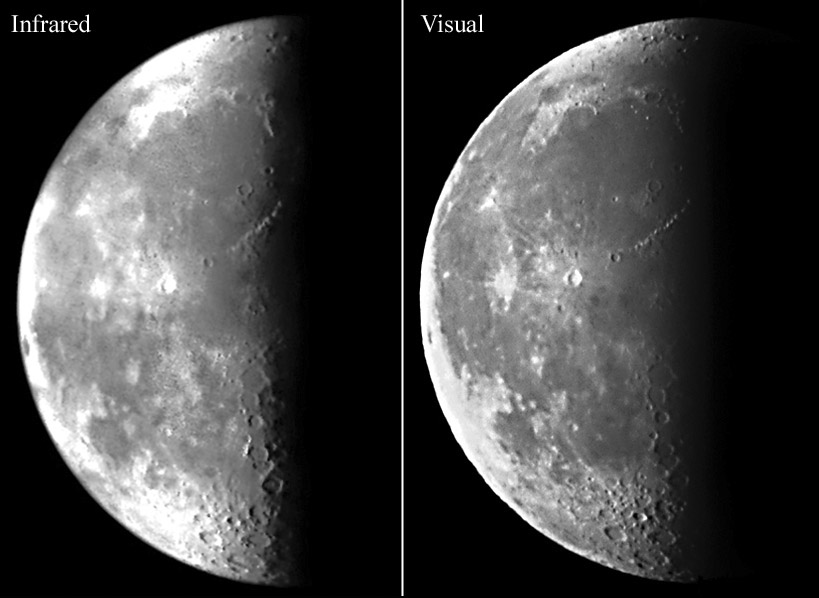Difference between revisions of "February 10, 2010"
| Line 6: | Line 6: | ||
<em>images by [mailto:jayem4646@eircom.net John Moore], Ireland</em><br /> | <em>images by [mailto:jayem4646@eircom.net John Moore], Ireland</em><br /> | ||
<br /> | <br /> | ||
| − | The enclosed image shows (left) a 'Infrared' and (right) a visual' view of the Moon taken 6 Feb 2010, GMT 7.30am. They look similar in ways, however, as the former image was made with simply transforming a normal digital camera into a infrared camera, I wonder would LPODers with more powerful scopes be able to produce much better views in the IR (I used just a 4-1/2" reflector). I'm not sure, however, if any valuable science may be gained from it though. I'm thinking along lines that as infrared technology may not be 'believed' available, generally, LPOD visitors might want to try this digital conversion with old cameras they have lying around, and do this simple experiment (it might also prove useful with imaging the [https://the-moon.us/wiki/ | + | The enclosed image shows (left) a 'Infrared' and (right) a visual' view of the Moon taken 6 Feb 2010, GMT 7.30am. They look similar in ways, however, as the former image was made with simply transforming a normal digital camera into a infrared camera, I wonder would LPODers with more powerful scopes be able to produce much better views in the IR (I used just a 4-1/2" reflector). I'm not sure, however, if any valuable science may be gained from it though. I'm thinking along lines that as infrared technology may not be 'believed' available, generally, LPOD visitors might want to try this digital conversion with old cameras they have lying around, and do this simple experiment (it might also prove useful with imaging the [https://the-moon.us/wiki/LPOD_Jan_31%2C_2008 faintest of moon crescents]. I've put up [http://www.moonposter.ie/infrared.htm a description] on how to make the 'Infrared' conversion. Another experiment that I'd like to investigate more is to view the Moon using the "thermal' cameras (as used on houses to see how insufficiently insulated they are) attached to the scope. They are very expensive and I don't have one, however, perhaps someone (e.g. college students/researchers working in physics and geology departments) might have access to one? I'm not sure how such 'thermal' images might turn out (if an image at all), however, it might be possible to show the varying, temperature changes around certain craters/regions etc., particularly on the terminator regions where heat is dissipating. <br /> |
<br /> | <br /> | ||
[mailto:jayem4646@eircom.net John Moore],<br /> | [mailto:jayem4646@eircom.net John Moore],<br /> | ||
Latest revision as of 18:45, 13 October 2018
New Views

images by John Moore, Ireland
The enclosed image shows (left) a 'Infrared' and (right) a visual' view of the Moon taken 6 Feb 2010, GMT 7.30am. They look similar in ways, however, as the former image was made with simply transforming a normal digital camera into a infrared camera, I wonder would LPODers with more powerful scopes be able to produce much better views in the IR (I used just a 4-1/2" reflector). I'm not sure, however, if any valuable science may be gained from it though. I'm thinking along lines that as infrared technology may not be 'believed' available, generally, LPOD visitors might want to try this digital conversion with old cameras they have lying around, and do this simple experiment (it might also prove useful with imaging the faintest of moon crescents. I've put up a description on how to make the 'Infrared' conversion. Another experiment that I'd like to investigate more is to view the Moon using the "thermal' cameras (as used on houses to see how insufficiently insulated they are) attached to the scope. They are very expensive and I don't have one, however, perhaps someone (e.g. college students/researchers working in physics and geology departments) might have access to one? I'm not sure how such 'thermal' images might turn out (if an image at all), however, it might be possible to show the varying, temperature changes around certain craters/regions etc., particularly on the terminator regions where heat is dissipating.
John Moore,
Technical Details
6 February 2010, GMT 7:30am. Digital camera, 4.5" reflecting telescope. (Lat: 51.9N, Long: 8.47W).
Related Links
John's Moon Atlas website
Yesterday's LPOD: Too Small To Fail?
Tomorrow's LPOD: Troubled Floor
COMMENTS?
Register, Log in, and join in the comments.



